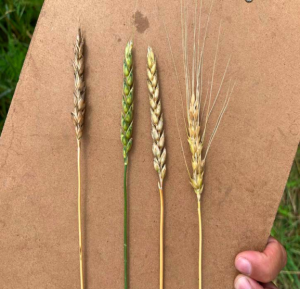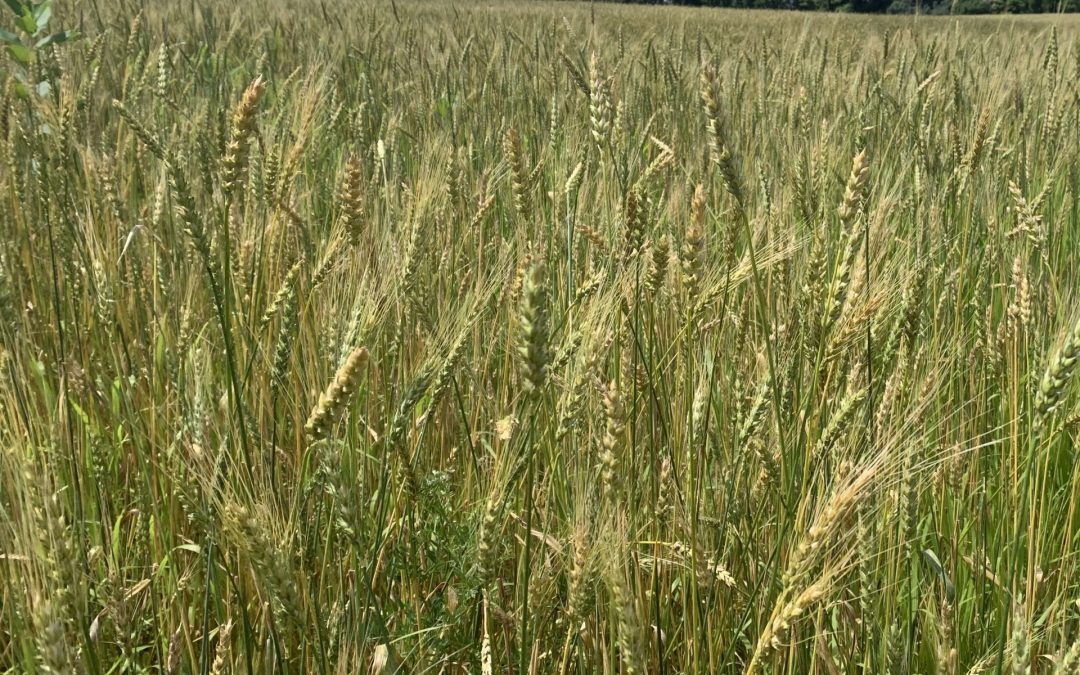by Jackie Clark
As you drive through rural Ontario, it’s not uncommon to come across hundreds of acres of uninterrupted corn or soybeans. These vast oceans of monoculture field crops are a relatively modern approach, adopted to accommodate ever-growing farm machinery and demand for uniform commodity products. However, historic and even ancient agricultural practices tend toward more diversity. Cereal species mixtures, called maslins, were widespread in Eurasia and Northern Africa and are still common today in Caucasus, the Greek Islands and the Horn of Africa, according to an October 2022 review in Agronomy for Sustainable Development by researchers McAlvay et al.
Closer to home, growing “wheat, oats and barley together is a very traditional practice that was used right up until the 1970s in Canada to produce livestock feed,” says Dr. Martin Entz, a professor in the Department of Plant Science at the University of Manitoba. For centuries, growers from many different places and cultures have blended together multiple varieties and/or species of grain to capture the benefits of broader genetic diversity within a field. The McAlvay et al review found that the lived experience of farmers demonstrated that maslins can preserve yield when faced with biotic and abiotic stresses like marginalized soils and variable precipitation — and experimental trials support that conclusion. Including multiple species allows for a greater diversity of genetic traits than varietal mixtures, and can lead to benefits including reduced pest susceptibility and improved resource use efficiency through different physiological structures reducing direct competition.
Year over year, maslins can provide climate adaptability through “passive shifts in species composition in response to environmental pressures,” reports McAlvay et al. Jellybean Populations in Manitoba Dr. Martin Entz has experience working different types of grain mixtures, including multi-line populations of single species that are often used in organic production in Europe.
Jellybean Populations in Manitoba
Entz developed what he calls “jellybean populations” by taking the 6th generation of wheat from 35 farmer breeders who had been selecting on their farm for three consecutive years. He did the same thing with 4th generation oats. For each species, “we took a representative sample from each of those farmers and put it into one bag and we are planting it every year,” he explains. The seed is available for farmers to grow themselves, which is “allowing that mixture to evolve in organic production.” With these multilines you can create a wheat or oat product that is quite uniform “even though its genetic base is quite broad,” Entz adds. “The idea is that we never really have a stable population, that’s by design. We want to have continual evolution.”
The wheat was first grown in 2020 in Swift Current, Saskatchewan. The multi-grain yielded less than the solo variety the farmer grew on another field, however “the multi-grain had many fewer weeds so there was an advantage,” Entz says.
Better weed and disease tolerance allowing for preserved yield with more ecological pest management is one of the potential benefits of growing mixed grain varieties or maslins. Diversifying crops through intercropping involves harvesting and selling or using the two or more different products separately, whereas a maslin creates one product of mixed grain. Mixed grains are typically marketed as blends for livestock feed — market development is one of the challenges of increasing the adoption of this practice, says Entz.
“I think we have to prepare ourselves for many different futures and this is one way to approach creating a little bit more of a climate resilient crop,” he says.
Experimenters in Ontario
Austin Bruch is an innovator in Ontario agriculture, constantly experimenting with agronomy, crop physiology and breeding.
“I started growing grains as a break crop between vegetables for soil health and weed control. I have always been interested in polycropping as it is a risk mitigation tool and can reduce input requirements,” he explains. When Bruch had leftover rye, barley, spelt, wheat, and pea seed from another experiment, he put them together and grew the mix.
“I like the mix and would definitely do it again,” he says. Growing mixes can be a good opportunity for farmers, depending on processing capabilities and market availability, he explains. Mixes can also be used for cover crop seed or livestock feed.
Chris Wooding grows many varieties and species of heirloom and heritage grains at Ironwood Organics in Athens, Ontario. In fact, he’s currently growing many varieties and species of grains in one particular field on his farm. Inspired by grain polycultures in desert high drylands of Ethiopia and Afghanistan, Wooding is experimenting with maslins. He seeded a field with a mixture of:
- 25 kg of Iron Fife, Ironwood Organics’ custom polyculture of four varieties; Preston, Hope, White Fife, Rouge de Bordeaux
- 5 kg of Hope, which is one of two Canadian varieties resistant to Ug99 (stem rust)
- 2 kg of naked barley
- 1.5 kg naked oat
- 0.5 kg of Stanley
- 0.5 kg of Red Bobs
- 0.5 kg of a landrace durum
- 5 kg bag of “stuff I have leftover from our spring trials”

The four grains that make up Iron Fife, Ironwood Organics’ custom polyculture
“There may be as many as 70 really different varieties in there,” Wooding told attendees at an EFAO field day hosted on July 21. He describes the benefits of the mixture like ‘social distancing,’ preventing the spread of disease to different individual plants of the same species/variety. He hopes to capture the benefits of lower disease susceptibility and increased nutrient density.
Trying to match maturity dates specifically is less important now that the climate is so unpredictable, he says, however maturity and harvesting is still a challenge for maslins. Once grains are dry, they’re “a ticking time bomb” Wooding says. At any point, grains may shatter, and provide volunteers for the next season’s crop. However he believes maslins are the next logical step in the progression of capturing the benefits of diversity in grain growing.
Below ground, maslins may also benefit the soil biome, Wooding explains. Different species will have diverse mycelium structures, and therefore improve soil nutrient utilization and extend the timing and variety of root exudates building glomalin (a protein produced by mycorrhizal fungi) in the soil.
Grains for the Future
“Maslins can be conceptualized as an intermediate strategy between varietal mixtures and multi-family polycultures that might be employed to balance trade-offs, while also possessing unique characteristics,” concludes McAlvay et al.
“A concerted global effort to characterize and revitalize maslins has been limited, with literature heavily siloed by disciplines and languages,” they explain. “However, from the available literature on farmer experiences and agronomic trials, these interspecific cereal mixtures appear to possess the potential for a variety of desirable characteristics which may be advantageous in adapting cropping systems to climate change— including heightened yield advantage, yield stability, pest and pathogen resistance, weed suppression, and drought tolerance.”
Innovators like Entz, Burch and Wooding are expanding our knowledge on current applications of grain mixtures, including variety blends, multi-line populations, and especially maslins, which hold the potential to help grains thrive in unfavorable and unpredictable conditions.
Jackie Clark is EFAO’s Small Grains Program Manager, helping encourage farmers to realize the benefits of incorporating small grains in field crop rotations. She is also an accomplished writer and former journalist.

